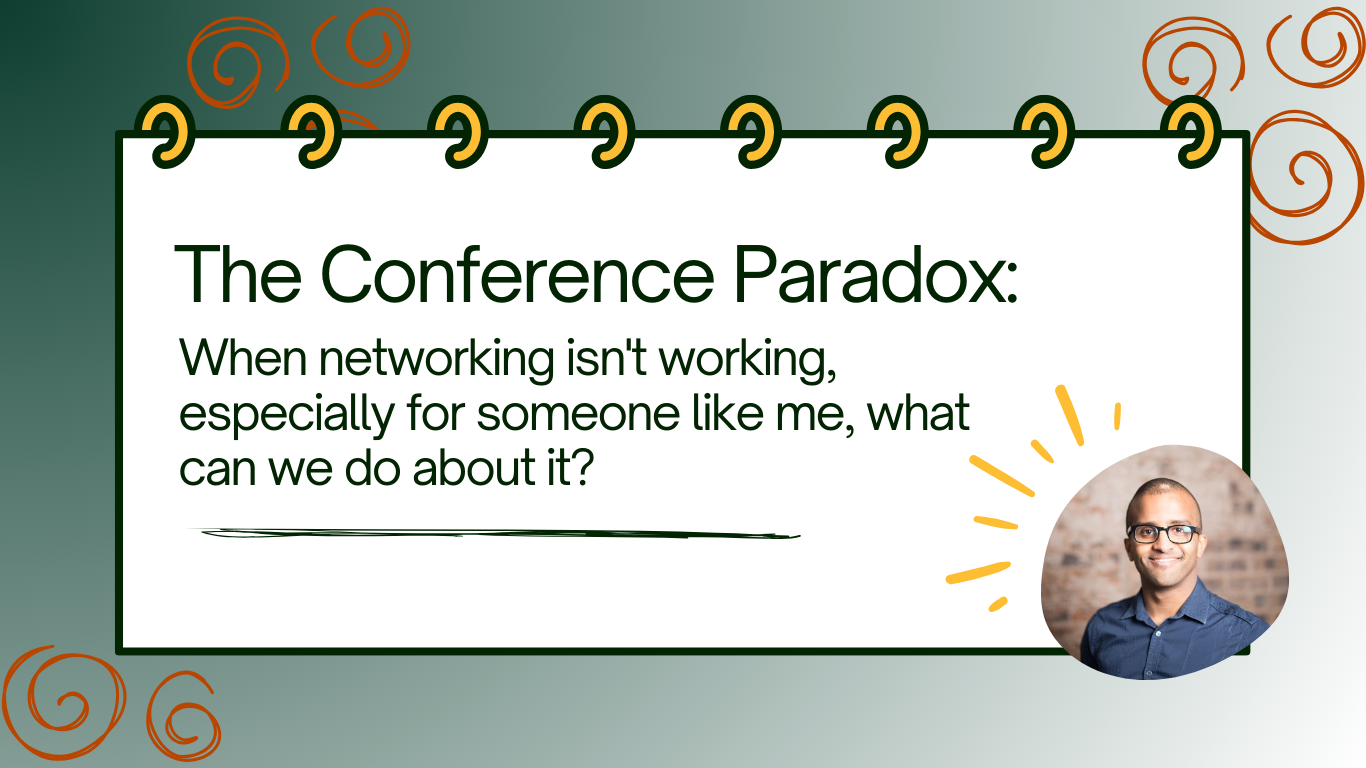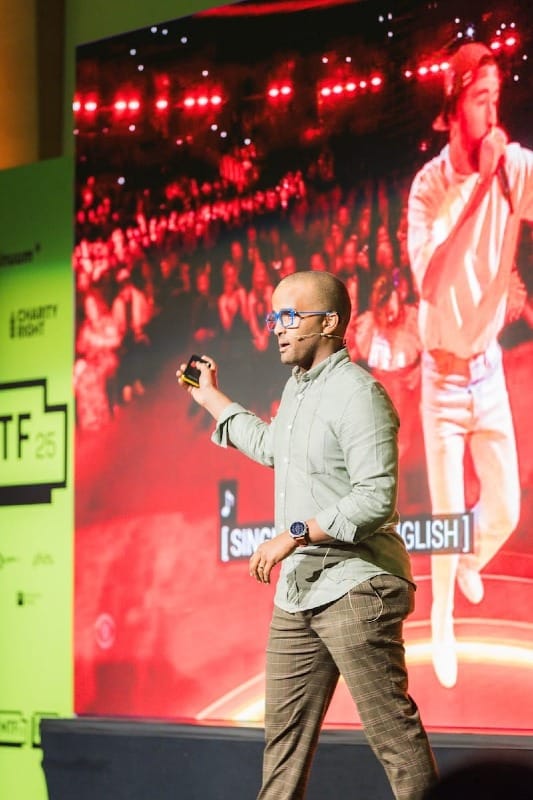The Conference Paradox: when networking isn't working
As an accessibility expert, I face a frustrating irony: speaking about inclusion on stage, then struggling to network due to the very barriers I just presented about. Here's how we can fix conference networking for everyone.

Picture this: I'm standing on stage at a major tech conference, delivering a keynote about digital accessibility. The audience is engaged, social media posts are flying, and I'm in my element.
Then I step off stage and immediately face the very barriers I just spoke about.
Welcome to the irony of my professional life: I'm an accessibility expert who struggles to access networking opportunities at the very events where I speak about it.
I want to attend conferences, whether as a speaker or not. The appeal of mingling with industry peers, forming meaningful connections, and creating business opportunities is strong.
But here's the thing nobody talks about: it's not as straightforward as just showing up.
For me, the sensory experience of conference venues is overwhelming. The constant buzz of conversations makes it hard to hear clearly. The strain of trying to follow un-captioned talks, working twice as hard just to stay engaged with those speaking on stage and in the hallways.
I've declined the speakers' dinners and the pre/post-event parties. Trust me, I want to be there, but before the conferences start, navigating multiple noisy environments feels like one challenge too many.
There is a constant internal conflict between professional ambition and practical limitations that creates a unique kind of loneliness. It's not just about being alone in a crowd; it's about wanting to fully participate while facing barriers that others might not notice.
But I have to endure and fight through, which isn't sustainable over a day or the length of the event's duration.
I'm not alone in this experience. The person with social anxiety who has spent weeks psyching themselves up to attend, only to feel overwhelmed by the crowd.
The neurodivergent attendee who's struggling with sensory overload from fluorescent lights and overlapping conversations.
The introvert who gives brilliant presentations but needs quiet time to recharge between sessions.
The non-native English speaker who's second-guessing every interaction.
The person using mobility aids who can't access those 'informal networking spots' because there's no lift to the mezzanine level.
While conferences are meant to be places of connection, they can amplify feelings of isolation for anyone whose networking style doesn't match the standard formula.
And that's without the added challenges of attending an alone too.
When you're constantly calculating the energy cost of each interaction, wondering if you'll hear correctly or if you'll need to ask someone to repeat themselves yet again, simple social anxiety can spiral into a self-fulfilling prophecy of isolation. The fear of miscommunication can deter others, creating a cycle that's hard to break.
But this isn't just my personal story. It's a call for change in how we think about and design professional gatherings.
Attending as a public speaker

Ironically, I'm often invited to speak on accessibility at these conferences.
Before I'm on stage, I prepare my talk somewhere quiet and use that as an escape hatch. This creates a legitimate excuse to step away from overwhelming networking spaces.
Then when it's time, I stand on stage and deliver what I'm there to do.
I love doing that. I get excited being on stage and enjoy working alongside event organisers (who have a tough job and deserve respect).
For those precious minutes, I'm in my element. I'm controlling the environment, sharing insights about creating inclusive spaces. The audience nods, takes notes, shares quotes on social media.
Then I step off stage and the barrier begins.
This may be hard to believe but for me, it's easier to speak in front of a large audience than speak to one person in a noisy environment.
The challenges don't discriminate based on my role. Whether I'm there as a speaker sharing expertise from the stage, an attendee seeking knowledge in the audience, or an exhibitor trying to make meaningful connections, the barriers remain constant. Different badge, same struggles.
These challenges have given me unique insights into making conferences truly inclusive. When you experience these barriers firsthand, both as someone on stage highlighting them and someone in the crowd navigating them, you develop a vision of what needs to change.
The (false) Great Networking Promise

We've all seen those messages:
"Join us for the ultimate networking experience!"
"Unlock career-changing connections!"
"Network with 1000+ industry leaders!"
Every conference dangles these promises. They paint quite a picture: you'll have deep conversations over fancy coffee, make breakthrough connections at lunch, and watch your career transform at those magical evening receptions.
If only it were that simple. Just show up, grab your name badge and watch the magic happen. That's not the case.
For example, those "intimate roundtable discussions" are frustrating. They're often placed right in the centre of the noise, where conversations from all directions collide. These sessions, usually featuring speakers and industry leaders I'd love to learn from, become an impossible task of straining to hear even fragments of conversation. Those "dynamic networking breaks" transform into anxiety-inducing obstacle courses of competing conversations and missed social cues.
The standard conference formula assumes we all thrive in the same environment: bright lights, constant background chatter, rapid-fire conversations while balancing a coffee cup and trying to read name badges.
In a typical scenario, I ask myself the following questions:
- Do I have enough energy left to navigate another loud space?
- Can I position myself where the lighting allows me to read lips?
- Can I position myself close enough to the stage to hear the speaker better
- How is the ambient and acoustic of room? Is it echoey that makes harder to hear people?
These aren't just minor inconveniences; they're barriers to the connections these events promise to facilitate.
When you don't have the same experience as those smiling faces in the conference promotions, it's easy to feel like you're the problem. But you're not. The issue lies in our narrow definition of professional connections, and it's time we questioned these assumptions.
Reimagining conference spaces
There's no universal solution here. Everyone experiences conferences differently. That means we need flexible approaches. I have a few suggestions:
Considerations for physical space
I've lost count of how many times I've had to choose between joining in or saving energy. Here's what I've learned: minor adjustments to physical spaces can make a significant difference.
- Lighting and acoustics can be the difference between inclusion and isolation. I've seen both sides: venues that got it right (where I could actually network) and others where mood lighting made lip-reading impossible and background noise turned every conversation into a guessing game.
- Different spaces work for different people and situations. Some thrive in the energy of an open networking area, while others need quieter corners for meaningful dialogue. The key isn't to eliminate one in favour of the other, but to provide options that accommodate various needs and preferences.
- But I know it’s not always possible for event organisers to have control over what you can do with that space, as they don’t own the venue.
Possibilities for event format
Not everyone networks the same way (shocking, right?). I feel comfortable on the main stage but struggle at the reception, while someone else loves small group chats but feels anxious in formal networking sessions.
That's life. That's being human.
Here's what would work better:
- Want a real conversation? Book one-to-one meetings in quiet spaces.
- Prefer small groups? Set up discussions away from the noise.
- Like to plan ahead? Use digital networking before and after the event.
- Need flexibility? Vary the formats so everyone can find their comfort zone.
Communication Solutions
Sometimes the simplest changes make a significant difference. Here's what works:
- Face the person you are speaking to. Not only it's a positive body language, but it's easier to hear and "read" a person.
- Got something important to discuss? Suggest a quieter place like a lobby or a dedicated networking area if that exists
- Someone asks you to repeat something? No problem - just do it!
- Share contact details in multiple ways (not everyone can hear your email address in a noisy hall).
- Clear communication helps everyone, not just those who need it most.
No single format will work for everyone, and that's okay. The goal isn't to find a perfect solution, but to create various pathways to meaningful connection.
These suggestions aren't about creating a perfect conference, an impossible goal I can attest to. Instead, they're about recognising that accessibility and inclusion look different for everyone.
Looking Forward

Conferences can connect, inspire, and transform careers. The current format presents challenges but also offers opportunities for meaningful change that benefits everyone.
At events I've spoken at, organisers have actively communicated with strong intentions to improve things. I appreciate it's not always possible with things out of your control, like the hiring venue's offerings. The intention and actions are there.
Every small improvement enhances the experience for all attendees, such as adding a quiet networking space or being mindful of communication needs. Who doesn't appreciate clearer conversations, comfortable spaces, and the choice to network in ways that suit their style?
The future of conferences isn't about special accommodations for some. It's about creating environments where everyone can engage effectively. Designing spaces and experiences for those facing the biggest barriers benefits all attendees, fostering stronger connections, deeper engagement, and greater value.
Next time you're effortlessly chatting away at a conference coffee break, just glance around. Notice who's standing at the edges, who might need a different approach to connect. The goal isn't to fix everyone's experience. It's simply to remember that not everyone's networking journey looks like yours.
From my own event organising experience, I know that a highly engaged mix of attendees is key to a successful conference, both for all the attendees and the event organisers.
I want to help to make it happen and I hope you will help too, however that looks.
